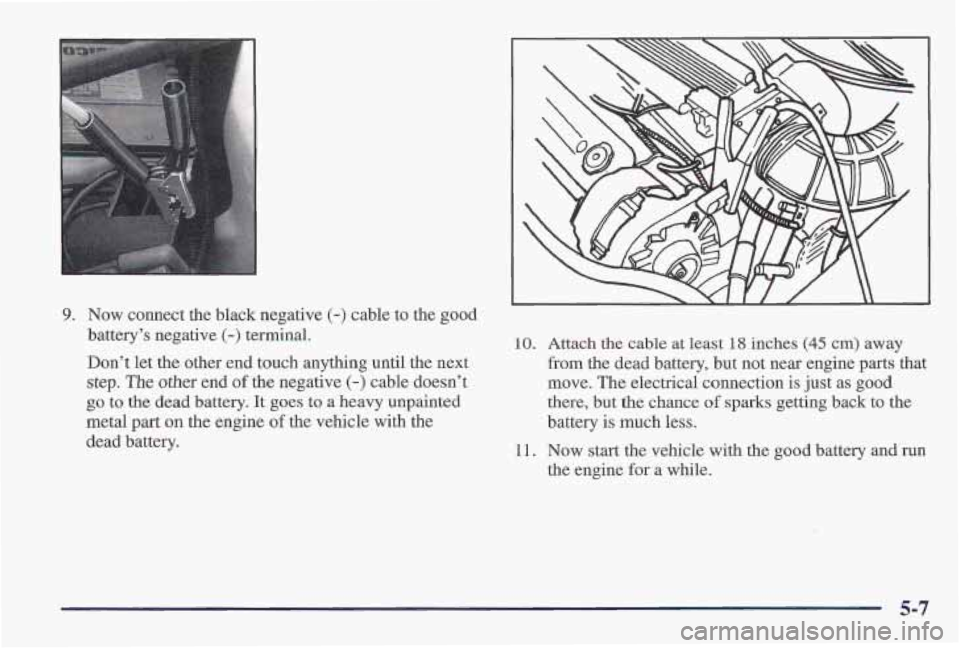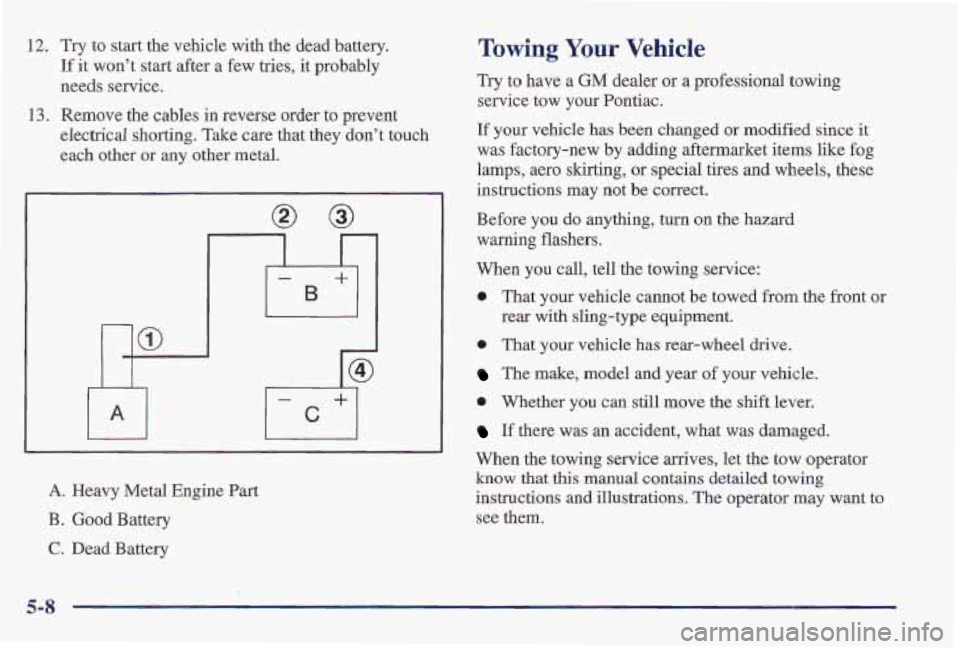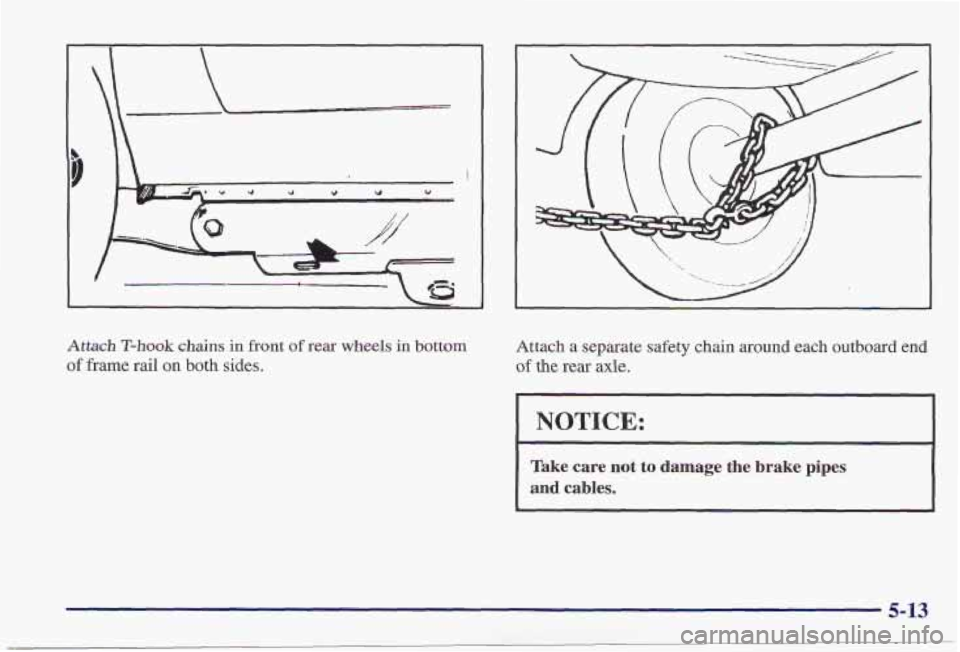PONTIAC FIREBIRD 1997 Owners Manual
Manufacturer: PONTIAC, Model Year: 1997, Model line: FIREBIRD, Model: PONTIAC FIREBIRD 1997Pages: 410, PDF Size: 19.2 MB
Page 211 of 410

7. Connect the red positive (+) cable to the positive (+>
terminal ‘of the vehicle with the dead battery. Use a
remote positive (+) terminal if the vehicle has one,
Don’t use the junction block on your Pontiac.
8. Don’t let the other end
touch metal. Connect it
to the positive (+)
terminal of the good
battery. Use a remote
positive
(+) terminal if
the vehicle has one.
5-6
Page 212 of 410

9. Now connect the black negative (-) cable to the good
battery’s negative
(-) terminal.
Don’t let the other end touch anything until the next
step. The other end of the negative (-) cable doesn’t
go to the dead battery. It goes to a heavy unpainted
metal part
on the engine of the vehicle with the
dead battery.
10. Attach the cable at least 18 inches (45 cm) away
from the dead battery, but not near engine parts that
move. The electrical connection is just as good
there, but the chance
of sparks getting back to the
battery is much less.
the engine for a while.
11. Now start the vehicle with the good battery and run
5-7
Page 213 of 410

12. Try to start the vehicle with the dead battery.
If it won’t start after a few tries, it probably
needs service.
13. Remove the cables in reverse order to prevent
electrical shorting. Take care that they don’t touch
each other
or any other metal.
A. Heavy Metal Engine Part
B. Good Battery
C. Dead Battery
Towing Your Vehicle
Try to have a GM dealer or a professional towing
service tow your Pontiac.
If your vehicle has been changed or modified since it
was factory-new by adding aftermarket items like fog
lamps, aero skirting, or special tires and wheels, these
instructions may not be correct.
Before you
do anything, turn on the hazard
warning flashers.
When
you call, tell the towing service:
0 That your vehicle cannot be towed from the front or
rear with sling-type equipment.
0 That your vehicle has rear-wheel drive.
The make, model and year of your vehicle.
0 Whether you can still move the shift lever.
If there was an ac’cident, what was damaged.
When the towing service arrives, let the tow operator
know that this manual contains detailed towing
instructions and illustrations. The operator
may want to
see them.
5-8
Page 214 of 410

To help avoid injury to you or others:
Never let passengers ride in a vehicle that is
0 Never tow faster than safe or posted speeds.
Never tow with damaged parts not
fully secured.
0 Never get under your vehicle after it has
been lifted
by the tow truck.
Always secure the vehicle on each side with
separate safety chains when towing it.
0 Never use J-hooks, Use T-hooks instead.
being towed.
A vehicle
can fall from a car car
adequately secured. This can cause a collision,
serious personal injury and vehicle damage. The
vehicle should be tightly secured with chains or
steel cables before
it is transported.
Don’t use substitutes (ropes, leather straps,
canvas webbing, etc.) that can be cut by sharp
edges underneath the towed vehicle. Always use
T-hooks inserted in the T-hook slots. Never use
J-hooks, They will damage drivetrain and
suspension components.
When your vehicle is being towed, have the ignition key
turned to the
OFF position. The steering wheel should
be clamped in a straight-ahead position, with a clamping
device designed for towing service.
Do not use the
vehicle’s steering column
lock for this. The transmission
should
be in NEUTRAL (N) and the parking
brake released.
Page 215 of 410

Don’t have your vehicle towed on the drive wheels
unless
you must. If the vehicle must be towed on the
drive wheels, be sure to follow the speed and distance
restrictions
later in this section or your transmission will
be damaged.
If these limits must be exceeded, then the
drive wheels have
to be supported on a dolly,
Front Towing
Tow Limits - 35 mph (56 kd), 50 miles (80 km)
NOTICE:
-
Do not tow with sling-type equipment or
fascidfog light damage will occur.
Use wheel lift or car carrier equipment.
Additional ramping
may be required for car
carrier equipment.
Use safety chains and wheel straps.
Attach T-hook chains to slots in frame rearward of front
wheels
on both sides.
I NOTICE: I
Do not attach winch cables or J-hooks to
suspension components when using car
carrier
equipment. Always use T-hooks inserted in the
T-hook slots,
5- 10
Page 216 of 410

Attach a separate safety chain around outboard end of
each lower control
arm.
I NOTICE:
I
Take care not to damage the brake pipes and
hoses or the
ABS sensor and wiring.
NOTICE:
Towing a vehicle over rough surfaces could
damage
a vehicle. Damage can occur from
vehicle-to-ground or
vehicle-to-wheel-lift-equipment contact. To help
avoid damage, install a towing dolly and raise
vehicle until adequate clearance
is obtained
between the ground
and/or wheel-lift equipment.
5-11
Page 217 of 410

Rear Towing
NOTICE:
Do not tow with sling-type equipment or
rear bumper valance will be damaged,
Use wheel-lift
or car carrier equipment.
Additional ramping may be required for
car-carrier equipment.
Use safety chains and wheel straps.
Towing
a vehicle over rough surfaces could
damage a vehicle. Damage can occur from
vehicle to ground
or vehicle to wheel lift
equipment contact.
To help avoid damage,
install
a towing dolly and raise vehicle until
adequate clearance is obtained between the
ground and/or wheel-lift 'equipment.
Do not attach winch cables or J-hooks to
suspension components when using car carrier
equipment. Always use
T-hooks inserted in the
T-book slots.
5-12
Page 218 of 410

r
Attach T-hook chains in front of rear wheels in bottom
of frame rail on both sides.
Attach a separate safety chain around each outboard end
of the rear axle.
I NOTICE:
Take care not to damage the brake pipes
and cables.
5-13
Page 219 of 410

Engine Overheating
You will find a coolant temperature gage on your
Pontiac's instrument panel. You may also find a LOW
COOLANT warning light on your Pontiac instrument
panel
(V8 Engine only).
If Steam Is Coming From Your Engine
Steam from an overheated engine can L,m you
badly, even if you just open the hood. Stay away
from the engine if you see or hear steam coming
from it. Just turn it off and get everyone away
from the vehicle until it cools down. Wait until
there is no sign
of steam or 'coolant before you
open the hood.
If you keep driving when your engine is
overheated, the liquids in it can catch fire. You or
others could be badly burned. Stop your engine if
it overheats, and get out of the vehicle until the
engine is cool.
-
NOTICE:
If your engine catches fire because yon keep
driving
with no coolant, your vehicle can be
badly damaged. The costly repairs
would not be
covered by your warranty.
5-14
Page 220 of 410

If No Steam Is Coming From Your Engine
If you get the overheat warning but see or hear no
steam, the problem may not be too serious. Sometimes
the engine can get a little too hot when you:
Climb a long hill on a hot day.
Stop after high-speed driving.
Idle for long periods in traffic.
Tow a trailer.
If you get the overheat warning with no sign of steam,
try this for a minute or
so:
1. If you have an air conditioner, turn it off.
2. Turn on your heater to full hot at the highest fan
speed and open the window as necessary.
3. If you’re in a traffic jam, shift to NEUTRAL (N);
otherwise, shift to the highest gear while
driving
-- AUTOMATIC OVERDRIVE (@) or
DRIVE (D) for automatic transmissions.
If you no longer have the overheat warning, you can
drive. Just to be safe, drive slower for about
10 minutes.
If the warning doesn’t come back on, you can
drive normally.
If the warning continues, pull over, stop, and park your
vehicle right away.
If there’s still no sign of steam, you can idle the engine
for two or three minutes while you’re parked, to see if
the warning stops. But then, if
you still have the
warning,
turn ofSthe engine and get everyone out of the
vehicle until it cools down.
You may decide not to lift the hood but to get service
help right away.
When you decide it’s safe to lift the hood, here’s what
you’ll see: